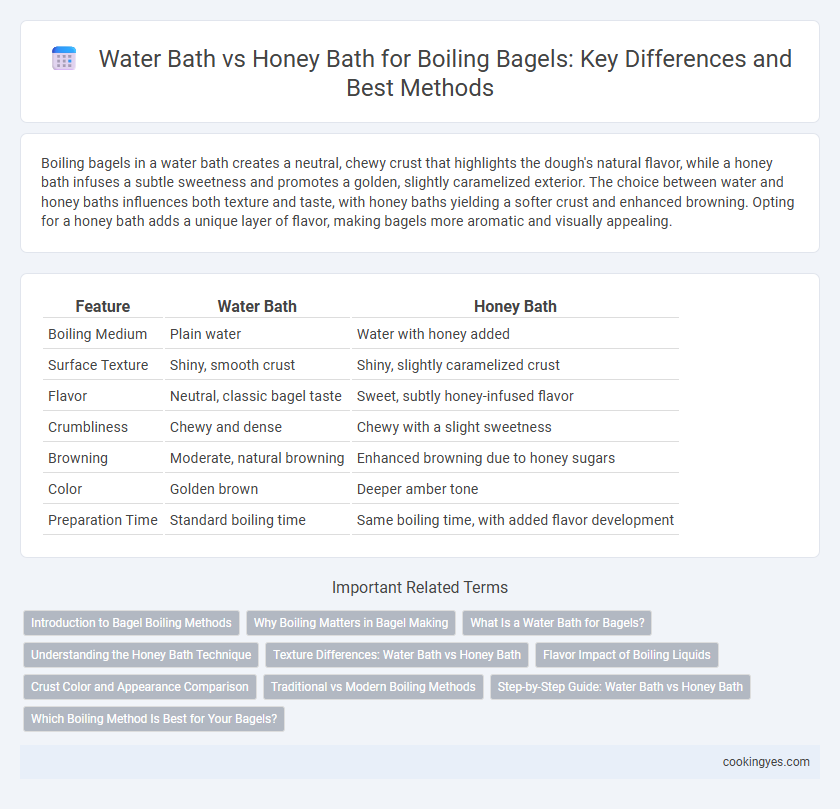Boiling bagels in a water bath creates a neutral, chewy crust that highlights the dough's natural flavor, while a honey bath infuses a subtle sweetness and promotes a golden, slightly caramelized exterior. The choice between water and honey baths influences both texture and taste, with honey baths yielding a softer crust and enhanced browning. Opting for a honey bath adds a unique layer of flavor, making bagels more aromatic and visually appealing.
Table of Comparison
| Feature | Water Bath | Honey Bath |
|---|---|---|
| Boiling Medium | Plain water | Water with honey added |
| Surface Texture | Shiny, smooth crust | Shiny, slightly caramelized crust |
| Flavor | Neutral, classic bagel taste | Sweet, subtly honey-infused flavor |
| Crumbliness | Chewy and dense | Chewy with a slight sweetness |
| Browning | Moderate, natural browning | Enhanced browning due to honey sugars |
| Color | Golden brown | Deeper amber tone |
| Preparation Time | Standard boiling time | Same boiling time, with added flavor development |
Introduction to Bagel Boiling Methods
Bagel boiling methods significantly influence texture and flavor, with water baths offering a neutral base that promotes a chewy interior and glossy crust. Honey baths infuse subtle sweetness and enhance browning due to the Maillard reaction, contributing to a distinctive golden hue and slight crispness. Selecting between water and honey boiling methods depends on desired taste profiles and crust characteristics in traditional New York-style bagels.
Why Boiling Matters in Bagel Making
Boiling bagels prior to baking gelatinizes the starch on the surface, creating a distinctive chewy crust and dense interior essential to authentic bagels. A water bath produces a neutral, crisp exterior, while a honey bath imparts subtle sweetness and a golden color due to caramelization. The boiling step controls the bagel's texture and appearance, directly impacting the final product's quality and traditional characteristics.
What Is a Water Bath for Bagels?
A water bath for bagels involves boiling the dough briefly in plain water, which creates a chewy crust and helps set the shape before baking. This traditional method allows starches on the surface to gelatinize, producing a shiny exterior and dense crumb. Water baths are often preferred for their simplicity and the classic texture they impart to bagels.
Understanding the Honey Bath Technique
The honey bath technique for boiling bagels involves adding honey to the boiling water, which imparts a subtle sweetness and promotes a glossy, golden crust. Unlike a plain water bath, the honey bath enhances caramelization on the bagel's surface, improving both flavor and texture. This method is preferred for achieving a slightly softer interior while maintaining a chewy, crisp exterior characteristic of traditional bagels.
Texture Differences: Water Bath vs Honey Bath
Boiling bagels in a water bath creates a chewy texture with a dense crumb and a slightly crisp crust, while a honey bath adds a subtle sweetness and promotes a glossy, slightly softer crust due to caramelization. The sugar content in honey interacts with the bagel's surface proteins, resulting in enhanced browning and a tender outer layer compared to the neutral effect of plain water. Bakers often prefer honey baths to achieve a balance of crispiness and softness, enriching both flavor and mouthfeel in the finished bagel.
Flavor Impact of Boiling Liquids
Boiling bagels in a water bath produces a classic, neutral crust that allows the natural flavors of the dough to shine, while a honey bath introduces subtle sweetness and a glossy, caramelized finish. The sugars in honey enhance Maillard reactions during baking, contributing to deeper flavor complexity and a slightly chewier texture. Choosing between water or honey for boiling directly influences the bagel's taste profile and crust appearance, tailoring the final product to specific flavor preferences.
Crust Color and Appearance Comparison
Using a water bath for boiling bagels typically results in a lighter crust with a pale, smooth appearance, while a honey bath enhances browning through caramelization, producing a deeper golden to amber crust color. The sugars in honey contribute to a shinier, glossier surface and a slightly thicker crust texture compared to the more matte finish from water baths. This difference in boiling medium significantly influences the bagel's visual appeal and texture before baking.
Traditional vs Modern Boiling Methods
Water bath boiling remains the traditional method for bagels, producing a chewy crust and dense interior by briefly submerging the dough in boiling water. Honey bath, a modern twist, incorporates honey or malt syrup into the boiling solution, enhancing flavor complexity and contributing to a glossy, slightly sweeter crust. Comparison of these techniques highlights water bath's classic texture preservation versus honey bath's subtle sweetness and improved crust sheen.
Step-by-Step Guide: Water Bath vs Honey Bath
Boiling bagels in a water bath creates a classic chewy crust by gelatinizing the starches on the surface, enhancing the traditional texture. Using a honey bath introduces natural sugars that caramelize during baking, giving the bagels a slightly sweeter flavor and a shinier, golden-brown crust. For a step-by-step guide, immerse shaped dough in boiling water for 30-60 seconds, optionally adding honey during boiling for extra sweetness, then bake immediately to seal in moisture and develop the perfect bagel crust.
Which Boiling Method Is Best for Your Bagels?
Boiling bagels in water produces a traditional chewy texture and glossy crust, while a honey bath adds a subtle sweetness and enhances browning for a richer flavor. The choice depends on desired taste; water boiling preserves classic bagel characteristics, whereas honey boiling creates a slightly caramelized exterior. For a balance of texture and flavor, experimenting with a mixture of water and honey can yield optimal results.
Water bath vs honey bath for bagel boiling Infographic

 cookingyes.com
cookingyes.com